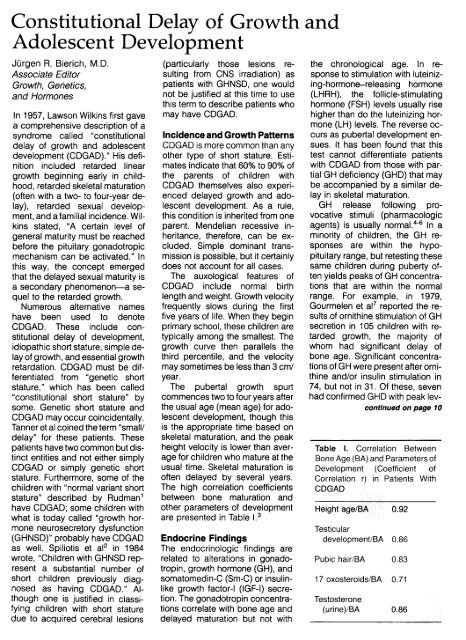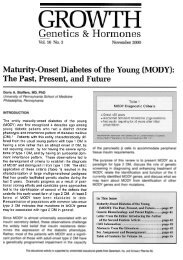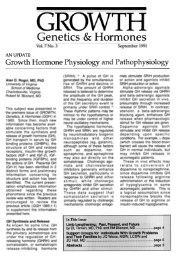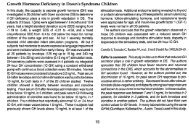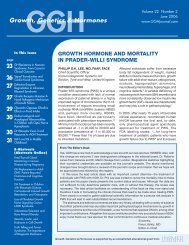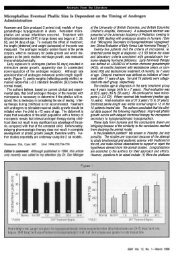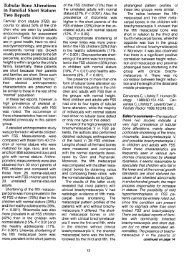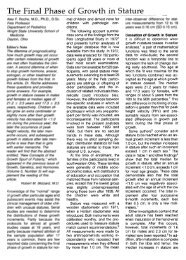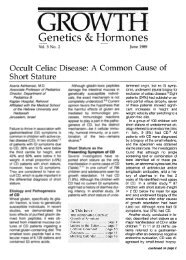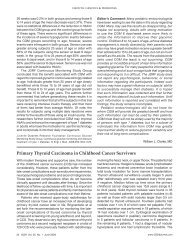Constitutional Delay of Growth and Adolescent ... - GGH Journal
Constitutional Delay of Growth and Adolescent ... - GGH Journal
Constitutional Delay of Growth and Adolescent ... - GGH Journal
Create successful ePaper yourself
Turn your PDF publications into a flip-book with our unique Google optimized e-Paper software.
<strong>Constitutional</strong> <strong>Delay</strong> <strong>of</strong> <strong>Growth</strong> <strong>and</strong><br />
<strong>Adolescent</strong> Development<br />
JOrgen R. Bierich, M.D. (particularly those lesions re- the chronological age. In re-<br />
Associate Editor suiting from CNS irradiation) as sponse to stimulation with luteiniz-<br />
<strong>Growth</strong>, Genetics, patients with GHNSD, one would ing-hormone-releasing hormone<br />
<strong>and</strong> Hormones not be justified at this time to use (LHRH), the follicle-stimulating<br />
this term to describe patients who hormone (FSH) levels usually rise<br />
In 1957, Lawson Wilkins first gave may have CDGAD. higher than do the luteinizing hora<br />
comprehensive description <strong>of</strong> a<br />
mone (LH) levels. The reverse ocsyndrome<br />
called "constitutional Incidence <strong>and</strong> <strong>Growth</strong> Patterns curs as pubertal development endelay<br />
<strong>of</strong> growth <strong>and</strong> adolescent CDGAD is more common than any sues. It has been found that this<br />
development (CDGAD)." His defi- other type <strong>of</strong> short stature. Esti- test cannot differentiate patients<br />
nition included retarded linear mates indicate that 60% to 90% <strong>of</strong> with CDGAD from those with pargrowth<br />
beginning early in child- the parents <strong>of</strong> children with tial GH deficiency (GHD) that may<br />
hood, retarded skeletal maturation CDGAD themselves also experi- be accompanied by a similar de-<br />
(<strong>of</strong>ten with a two- to four-year de- enced delayed growth <strong>and</strong> ado- lay in skeletal maturation.<br />
lay), retarded sexual develop- lescent development. As a rule, GH release following proment,<br />
<strong>and</strong> a familial incidence. Wil- this condition is inherited from one vocative stimuli (pharmacologic<br />
kins stated, "A certain level <strong>of</strong> parent. Mendelian recessive in- agents) is usually normal.4-s In a<br />
general maturity must be reached heritance, therefore, can be ex- minority <strong>of</strong> children, the GH rebefore<br />
the pituitary gonadotropic cluded. Simple dominant trans- sponses are within the hypomechanism<br />
can be activated." In mission is possible, but it certainly pituitary range, but retesting these<br />
this way, the concept emerged does not account for all cases. same children during puberty <strong>of</strong>that<br />
the delayed sexual maturity is The auxological features <strong>of</strong> ten yields peaks <strong>of</strong> GH concentraa<br />
secondary phenomenon-a se- CDGAD include normal birth tions that are within the normal<br />
que! to the retarded growth. length <strong>and</strong> weight. <strong>Growth</strong> velocity range. For example, in 1979,<br />
Numerous alternative names frequently slows during the first Gourmelen et al7 reported the rehave<br />
been used to denote five years <strong>of</strong> life. When they begin suits <strong>of</strong> ornithine stimulation <strong>of</strong> GH<br />
CDGAD. These include con- primary school, these children are secretion in 105 children with restitutional<br />
delay <strong>of</strong> development, typically among the smallest. The tarded growth, the majority <strong>of</strong><br />
idiopathic short stature, simple de- growth curve then parallels the whom had significant delay <strong>of</strong><br />
lay <strong>of</strong> growth, <strong>and</strong> essential growth third percentile, <strong>and</strong> the velocity bone age. Significant concentraretardation.<br />
CDGAD must be dif- may sometimes be less than 3 cm/ tions <strong>of</strong> GH were present after orniferentiated<br />
from "genetic short year. thine <strong>and</strong>/or insulin stimulation in<br />
stature," which has been called The pubertal growth spurt 74, but not in 31. Of these, seven<br />
"constitutional short stature" by commences two to four years after had confirmed GHD with peak levsome.<br />
Genetic short stature <strong>and</strong> the usual age (mean age) for ado- continued on page 10<br />
CDGAD may occur coincidentally. lescent development, though this<br />
Tanner et al coined the term "small/ is the appropriate time based on<br />
delay" for these patients. These skeletal maturation, <strong>and</strong> the peak<br />
patients have two common but dis- height velocity is lower than aver- Table I. Correlation Between<br />
tinct entities <strong>and</strong> not either simply age for children who mature at the Bone Age (BA) <strong>and</strong> Parameters <strong>of</strong><br />
CDGAD or simply genetic short usual time. Skeletal maturation is Development (Coefficient <strong>of</strong><br />
stature. Furthermore, some <strong>of</strong> the <strong>of</strong>ten delayed by several years. Correlation r) in Patients With<br />
children with "normal variant short<br />
stature" described by Rudman 1<br />
The high correlation coefficients<br />
between bone maturation <strong>and</strong><br />
CDGAD<br />
have CDGAD; some children with other parameters <strong>of</strong> development Height age/gA 0.92<br />
what is today called "growth hor- are presented in Table 1.3 .<br />
mone neurosecretory dysfunction<br />
Testicular<br />
(GHNSD)" probably have CDGAD Endocrine Findings development/SA 0.86<br />
as well. Spiliotis et al2 in 1984 The endocrinologic findings are<br />
wrote, "Children with GHNSD rep- related to alterations in gonado- Pubic hair/SA 0.83<br />
resent a substantial number <strong>of</strong> tropin, growth hormone (GH), <strong>and</strong><br />
short children previously diag- somatomedin-C (Sm-C) or insulin- 17 oxosteroids/BA 0.71<br />
nosed as having CDGAD." AI- like growth factor-I (IGF-I) secrethough<br />
one is justified in classi- tion. The gonadotropin con centra- Testosterone<br />
fying children with short stature tions correlate with bone age <strong>and</strong> (urine)/BA 0.86<br />
due to acquired cerebral lesions delayed maturation but not with
<strong>Constitutional</strong> Decay Of <strong>Growth</strong> II. These data indicate that pa- <strong>Growth</strong>, Genetics, <strong>and</strong> Hormones,<br />
And <strong>Adolescent</strong> Development tients with CDGAD secrete less Vol. 1, No.4).<br />
continued from page 9 GH at all stages <strong>of</strong> pubertal devel- At least three groups <strong>of</strong> investi-<br />
opment than do control children. gators have reported increased<br />
els.o! less th~n 3 ng/ml. The re-<br />
Differences between the patients<br />
<strong>and</strong> controls were statistically sig-<br />
IGF-I levels in tall children (com-<br />
pared with children <strong>of</strong> normal statmalnlng<br />
24 children were betwe~n nificant in all groups, except for ure); others have reported de-<br />
11 <strong>and</strong> 15 years <strong>of</strong> age <strong>and</strong> In those in stage 2 <strong>of</strong> sexual devel- creased IGF-I values in short<br />
pubertal stages 1 <strong>and</strong> 2. Their opment. The interpretation <strong>of</strong> children (compared with children<br />
peak GH levels were 3 to 8 ng/ml. these data prompts the hypothesis <strong>of</strong> normal size).19-21 Children with<br />
Ten <strong>of</strong>. these 24 were retested after that there is permanently dimin- CDGAD have IGF-I values in acreaching<br />
stage 3 <strong>of</strong> sexual devel- ished GH secretion. cord with their skeletal maturation<br />
opment, a~d they had peak GH A second form <strong>of</strong> growth delay, rather than with their chronological<br />
concentrations <strong>of</strong> between 8 <strong>and</strong> which is designated as "short stat- age. Link et al22 demonstrated that<br />
45 ng/ml, with a mean <strong>of</strong> 21 ng/ml.<br />
The authors interpreted these observations<br />
as indicative <strong>of</strong><br />
t" htran~~;-~~-P hartial GbHD." dOthedr au- Table II. Sleep-Induced GH Secretion in 124 Patients With CDGAD <strong>and</strong> 28<br />
ors ..av.e 0 serv~ an. re- Controls<br />
ported similar Instances In patients<br />
who appear to have GHD pre-<br />
Puberty stages<br />
pubertally but who have normal P1 P2 P3<br />
respo~ses to provocative tests (Number <strong>of</strong> cases) (86) (18)t (31) (3.)f (7) (7)t<br />
following the onset <strong>of</strong> puberty. Sleep-induced<br />
It is probably incorrect, how- GH secretion 2469** 4349 3347 5905 3580** 9794<br />
ever, to compare normal values 5V2 hrs :t 1068 :t 1134 :t 1619 -:t 1633 :t 1711<br />
obtained after the onset <strong>of</strong> puberty (ng/ml x 330 min)<br />
with the normal values found in<br />
prepubertal children. The mean Peak GH level 22.5*' 38.8 27.2 49.8 21.2' 66.2<br />
stimulated values in normal ado- :t 8.1 :t 27.0<br />
Ie scents are approximately twice<br />
those <strong>of</strong> prepubertal children. With 'Statistically significant difference v controls P > 001<br />
stimulation, patients with CDGAD "Statistically significant difference v controls P > 0.001<br />
reportedly do not have GH peaks tControl children<br />
<strong>of</strong> the same magnitude as do normal<br />
children during puberty.<br />
Because <strong>of</strong> the variability <strong>of</strong><br />
results obtained after pharma- ure due to an immunologically re- the administration <strong>of</strong> testosterone<br />
cologic stimuli, several au- active but biologically inactive to these patients increased both<br />
thors5.11-13 have examined the GH," is sometimes clinically indis- GH production <strong>and</strong> IGF-llevels. It<br />
spontaneous secretion <strong>of</strong> GH tinguishable from CDGAD. In this is on this basis, as well as upon the<br />
throughout the day or night or entity, growth retardation is pre- observation that IGF-I levels inaround<br />
the clock. In only a few sumed to result from the produc- crease early in puberty, that one<br />
instances were abormally low tion <strong>of</strong> a GH molecule that is bio- may hypothesize that testosterone<br />
peaks found during sleep, eg, in logically inactive, since the GH increases the circulating concentwo<br />
<strong>of</strong> 14 patients reported by levels are normal or high <strong>and</strong> IGF-I trations <strong>of</strong> GH <strong>and</strong> the generation<br />
Wise <strong>and</strong> colleagues.13 In 1979, is low as in GH-deficient children. <strong>of</strong> IGF-I in early adolescence.<br />
<strong>and</strong> again in 1985, Bierich <strong>and</strong> However, patients with this entity,<br />
co-workers14.15 investigated sleepinduced<br />
GH secretion. The<br />
which was described by Hayek<br />
<strong>and</strong> co-workers 16 <strong>and</strong> Kowarski et<br />
The Need for Therapy<br />
The need for therapy <strong>and</strong> the<br />
results in children with CDGAD al,17 are usually more severely re- treatment chosen should be conwere<br />
compared with those in tarded in growth than are patients sidered for each individual ch,ild.<br />
healthy controls with equivalent with CDGAD. Subsequent patients The adult stature eventually<br />
sexual maturation. These investi- also have been described by reached by children with CDGAD<br />
gators determined the area under Bierich et al,4 Rudman <strong>and</strong> co- varies considerably <strong>and</strong> is related<br />
the GH-v-time curve to obtain the workers,1 <strong>and</strong> Valenta et al. 18 The to the heights <strong>of</strong> the parents. The<br />
integrated total secretion over 5.5 only attempt to determine the majority <strong>of</strong> patients attain a height<br />
hours at night. The highest peak structure <strong>of</strong> GH was made by within the normal range, unless.<br />
levels were also determined. The Valenta et al,18 who proposed a they are in the small/delay catresults<br />
obtained from 124 patients circulating GH molecule <strong>of</strong> ab- egory. Nevertheless, Preece <strong>and</strong><br />
<strong>and</strong> 28 controls are shown in Table normal structure. (See abstract in colleagues23 first demonstrated
that the adult height <strong>of</strong> those with The use <strong>of</strong> testosterone is lim- GH <strong>of</strong> patients with CDGAD should<br />
CDGAD is below the mean for the ited to boys, usually 14 years <strong>of</strong> be reserved for the most severely<br />
general population. This was con- age <strong>and</strong> over, who have signifi- dwarfed children. Additional studfirmed<br />
by Ranke et al.24 Whether cant concern about their delayed ies under controlled conditions are<br />
therapy will increase ultimate sexual development. Martin <strong>and</strong> urgently required before GH<br />
height or whether it will affect only co-workers26 showed that doses treatment-outside <strong>of</strong> centers<br />
the rate <strong>of</strong> growth during treatment <strong>of</strong> 50 mg <strong>of</strong> a long-acting testos- where the efficacy <strong>of</strong> GH treatment<br />
is a question <strong>of</strong> great importance. terone ester (testosterone en- in patients who are not GH-<br />
If testosterone or <strong>and</strong>rogens are anthate) once a month will en- deficient is being studied-can be<br />
used, one must consider whether hance sexual development recommended for patients with<br />
adult height may be reduced. without affecting adult height. CDGAD.<br />
Treatment certainly is indicated in Doses <strong>of</strong> 100 mg or greater very The use <strong>of</strong> other agents, such<br />
many patients <strong>and</strong>, in particular, in possibly reduce the ultimate as growth-hormone-releasing<br />
adolescent boys who are psycho- stature. Treatment is <strong>of</strong>ten con- hormone (GHRH) <strong>and</strong> clonidine,<br />
logically less able to cope with tinued for six to 12 months, an alpha2 adrenergic drug that<br />
their shortness, their delayed sex- at which time the testosterone stimulates the release <strong>of</strong> GH, reual<br />
maturation, <strong>and</strong> their high- is discontinued to determine quires further study. Results evalpitched<br />
voices. At no other time in whether spontaneous puberty uating GHRH in the treatment <strong>of</strong><br />
childhood is the height gap with has occurred. Occasionally, a CDGAD have not been reported.<br />
relation to age mates as great as it repeat course <strong>of</strong> therapy begin- In 1985, Pintor et al29 administered<br />
is during early adolescence, par- ning six months after the end <strong>of</strong> clonidine to four patients with<br />
ticularly since the growth rate <strong>of</strong> the first course is appropriate. CDGAD over a period <strong>of</strong> two<br />
children with CDGAD reaches its months, <strong>and</strong> they described innadir<br />
at the same time that the Treatment with GH creased values <strong>of</strong> circulating GH<br />
adolescent growth spurt occurs in Studies evaluating GH for the <strong>and</strong> IGF-I <strong>and</strong> accelerated growth.<br />
normal children <strong>of</strong> the same age. treatment <strong>of</strong> CDGAD are few in However, this is an exceedingly<br />
Treatment should be seriously number. The first report <strong>of</strong> the suc- small series <strong>of</strong> patients treated for<br />
considered for patients who are in cessful administration <strong>of</strong> GH to a short period <strong>of</strong> time. Currently,<br />
danger <strong>of</strong> developing a severe in- such patients was from Grunt et al several investigators are involved<br />
feriority complex. One <strong>of</strong> two forms in 1972,27 who stimulated growth in studying the effect <strong>of</strong> clonidine<br />
<strong>of</strong> therapy can be chosen: the use in four <strong>of</strong> ten children with CDGAD. in CDGAD further.<br />
<strong>of</strong> testosterone with or without an- In a subsequent report by Kastrup<br />
abolic steroids, or the use <strong>of</strong> GH. et al,8 growth velocity rose from 3.7 Summary<br />
to 8.4 cm/year during therapy. CDGAD is the most common form<br />
Therapy With Testosterone Bierich <strong>and</strong> co-workers4 in 1983 <strong>of</strong> short stature. Preliminary stud<strong>and</strong>/or<br />
Anabolic Steroids reported an increased growth rate ies suggest that children with<br />
Testosterone <strong>and</strong>/or anabolic (from 4.1 cm/year to 8.3 cm/year) CDGAD have inadequate GH prosteroids<br />
have been employed for with therapy. Gertner <strong>and</strong> co- duction, whereas children <strong>of</strong> the<br />
many years to treat CDGAD. The workers28 have reported similar same age who do not have<br />
anabolic steroids are derived findings. Individual differences are CDGAD, have adequate GH pr<strong>of</strong>rom<br />
testosterone. With the pos- considerable, but the greater the duction. Some would call this a<br />
sible exception <strong>of</strong> ox<strong>and</strong>rolone delay in bone age, the better the physiological state (partial GHD).<br />
(Anavar), all anabolic steroids acceleration <strong>of</strong> growth velocity. In this sense, CDGAD is similar to<br />
display similar <strong>and</strong>rogenic or The growth rate in children with the previously described GHNSD.<br />
virilizing effects-including in- CDGAD had been maximal during Testosterone, <strong>and</strong> probably estrocreased<br />
skeletal maturation- the first year <strong>of</strong> treatment <strong>and</strong> de- gen as well, stimulates increased<br />
in comparison with testoster- creased thereafter, a pattern that production <strong>and</strong> secretion <strong>of</strong> GH.<br />
one. However, ox<strong>and</strong>rolone has occurs with GH-deficient patients This, in turn, stimulates increased<br />
a significant growth-promoting receiving GH. IGF-I concentrations in normal<br />
effect in relation to its minimal, Although adequate data are early puberty.<br />
modest virilizing action. At a presently unavailable to evaluate The use <strong>of</strong> GH as a therapeutic<br />
dosage <strong>of</strong> 0.1 mg/kg/day, oxan- the long-term effect <strong>of</strong> GH treat- agent in CDGAD is under clinical<br />
drolone has been used suc- ment on children with CDGAD, this investigation. Currently, oxancessfully<br />
in patients between the author has the clinical impression drolone (0.1 mg/kg/day) is the<br />
ages <strong>of</strong> 11 <strong>and</strong> 16 who are more that the growth prognosis <strong>of</strong> most treatment <strong>of</strong> choice in patients unconcerned<br />
about their height <strong>of</strong> these children improves. Since der 14 years <strong>of</strong> age who require a<br />
than their delayed sexual devel- none <strong>of</strong> the patients in our series growth-promoting agent for priopment.<br />
In Europe, Stanhope has reached final height, no defin- marily psychological reasons. De<strong>and</strong><br />
Brook25 reported favorable itive statements can be made re- potestosterone (long-acting enresults<br />
with ox<strong>and</strong>rolone in 24 garding an increase in ultimate anthate or cypronate) is the<br />
boys with CDGAD. height. At present, treatment with continued on page 12


